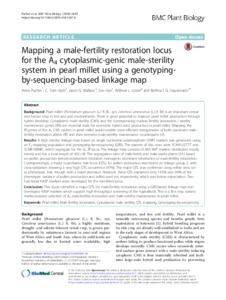Mapping a male-fertility restoration locus for the A4 cytoplasmic-genic male-sterility system in pearl millet using a genotyping-by-sequencing-based linkage map
Abstract
Background Pearl millet (Pennisetum glaucum (L.) R. Br., syn. Cenchrus americanus (L.) R. Br) is an important cereal and fodder crop in hot and arid environments. There is great potential to improve pearl millet production through hybrid breeding. Cytoplasmic male sterility (CMS) and the corresponding nuclear fertility restoration / sterility maintenance genes (Rfs) are essential tools for economic hybrid seed production in pearl millet. Mapping the Rf genes of the A4 CMS system in pearl millet would enable more efficient introgression of both dominant male-fertility restoration alleles (Rf) and their recessive male-sterility maintenance counterparts (rf). Results A high density linkage map based on single nucleotide polymorphism (SNP) markers was generated using an F2 mapping population and genotyping-by-sequencing (GBS). The parents of this cross were ‘ICMA 02777’ and ‘ICMR 08888’, which segregate for the A4 Rf locus. The linkage map consists of 460 SNP markers distributed mostly evenly and has a total length of 462 cM. The segregation ratio of male-fertile and male-sterile plants (3:1) based on pollen production (presence/absence) indicated monogenic dominant inheritance of male-fertility restoration. Correspondingly, a major quantitative trait locus (QTL) for pollen production was found on linkage group 2, with cross-validation showing a very high QTL occurrence (97%). The major QTL was confirmed using selfed seed set as phenotypic trait, though with a lower precision. However, these QTL explained only 14.5% and 9.9% of the phenotypic variance of pollen production and selfed seed set, respectively, which was below expectation. Two functional KASP markers were developed for the identified locus. Conclusion This study identified a major QTL for male-fertility restoration using a GBS-based linkage map and developed KASP markers which support high-throughput screening of the haploblock. This is a first step toward marker-assisted selection of A4 male-fertility restoration and male-sterility maintenance in pearl millet

